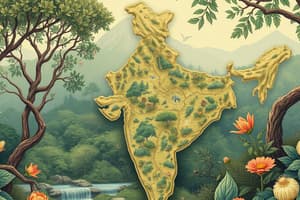Podcast
Questions and Answers
What is the primary reason people settle in certain geographic locations?
What is the primary reason people settle in certain geographic locations?
- Availability of resources for survival and growth (correct)
- Presence of family and friends
- Proximity to tourist attractions
- Accessibility to job opportunities
What is the main factor that determines the distribution of metallic minerals?
What is the main factor that determines the distribution of metallic minerals?
- Tectonic activity (correct)
- Latitude and altitude
- Climate and vegetation
- Landscape and soil type
What is a common reason for people to migrate to a new place?
What is a common reason for people to migrate to a new place?
- To access resources they need (correct)
- To escape from war
- To join a specific cultural community
- To experience different climates
What type of rocks are fossil fuels typically found in?
What type of rocks are fossil fuels typically found in?
What is an example of an economic activity directly related to resources?
What is an example of an economic activity directly related to resources?
Why do certain regions have smaller populations?
Why do certain regions have smaller populations?
How does trade help countries with limited natural resources?
How does trade help countries with limited natural resources?
What is the primary consequence of uneven resource distribution?
What is the primary consequence of uneven resource distribution?
What is often a root cause of conflicts between nations?
What is often a root cause of conflicts between nations?
What determines the standard of living in a place?
What determines the standard of living in a place?
Flashcards are hidden until you start studying
Study Notes
Resources and Their Distribution
- Resources are materials found in the environment that humans use for food, fuel, clothing, and shelter, including water, soil, minerals, vegetation, animals, air, and sunlight.
- People require resources to survive and thrive.
Factors Affecting Resource Distribution
- Low latitudes (near the equator) receive more sunlight and precipitation, while higher latitudes (near the poles) receive less sunlight and too little precipitation.
- Temperate deciduous forest biomes provide a moderate climate, fertile soil, timber, and abundant wildlife.
- Plains offer flat landscapes and fertile soil for growing crops, while steep mountains and dry deserts are more challenging.
- Metallic minerals are abundant in areas with strong tectonic activity, while fossil fuels are found in sedimentary rocks.
Consequences of Uneven Resource Distribution
- Resources are distributed unevenly across the globe.
- Human settlement and population distribution are influenced by geographic factors such as water, soil, vegetation, climate, and landscape.
- Areas with fewer geographic advantages, such as South America, Africa, and Australia, have smaller populations than North America, Europe, and Asia.
Human Migration and Economic Activities
- Large groups of people often migrate to places with abundant resources and away from places lacking resources.
- Examples of historical migrations include the Trail of Tears, Westward Movement, and the Gold Rush.
- Economic activities, such as farming, fishing, and mining, are directly related to the resources in a region.
Trade and Its Impact
- Countries may not have the resources they need, but trade enables them to acquire them from other places.
- Japan is an example of a country with limited natural resources that has achieved wealth through trade.
Conflict, Wealth, and Quality of Life
- Historical and present-day conflicts often involve nations trying to control resource-rich territories.
- The standard of living, measured by the quality and quantity of goods and services available, is influenced by the availability of natural resources.
- Wealth and prosperity do not solely depend on the presence or lack of natural resources within a country.
Studying That Suits You
Use AI to generate personalized quizzes and flashcards to suit your learning preferences.




